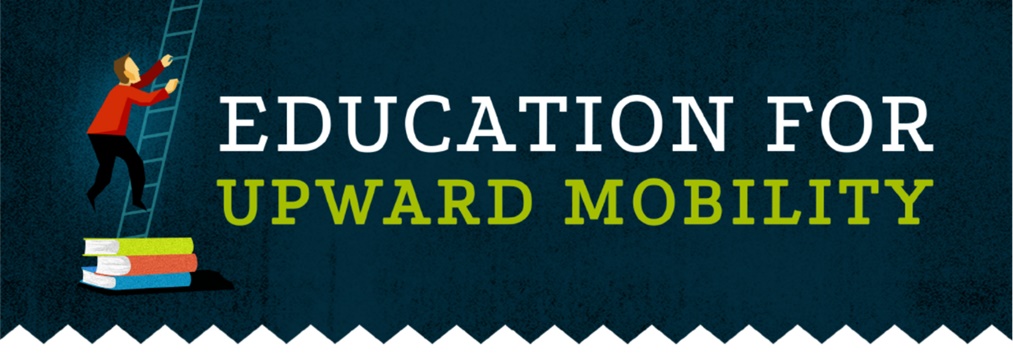
Facing facts: Ohio's school report cards in a time of rising expectations
A deep dive into the performance of Ohio’s public schools, statewide and in its eight largest urban areas

A deep dive into the performance of Ohio’s public schools, statewide and in its eight largest urban areas








On February 25, 2016, Ohio released report cards for the 2014-15 school year—the first in which the state administered next generation assessments. In conjunction with these new exams, state officials raised the minimum test score needed for students to be deemed “proficient.” As a result of these transitions, proficiency and achievement-based ratings fell across the state—a necessary reset of basic accountability measures in a time of rising expectations. This year’s report provides an overview of these changes, along with a presentation of data from national exams, suggesting that policymakers should go further to match Ohio’s definition of proficiency with a true college and career ready benchmark.
Since 2005, the Fordham Institute has conducted annual analyses of Ohio’s school report cards, with a particular focus on the performance of urban schools, both district and charter. This year’s analysis again takes a deep-dive look at the student achievement and school quality in the Ohio Big Eight areas. The key findings are as follows:
Download the report to learn more about the performance of Ohio’s public schools, statewide and in its eight largest urban areas.

The 2015 Fordham Sponsorship Annual Report is our opportunity to share the Fordham Foundation’s work as the sponsor of eleven schools serving approximately 3,200 students in five cities, and our related policy work in Ohio and nationally.
Charter school policy took a giant leap forward in Ohio in 2015 with the passage of HB 2. The road to a high-quality charter school sector has been laid out. If we want high-performing schools and networks to grow and replicate in the state, it is time to turn our attention to the human capital, facilities, and funding issues that have dogged the sector here for far too long.
We urge you to read this report to learn of Fordham’s commitment to quality schools for all children.

[Editor’s note: This is the third post in a series on improving teacher preparation programs. See here and here for prior posts.]
The traditional pathway toward becoming a teacher requires the completion of an undergraduate teacher preparation program. In Ohio, entry requirements for these programs aren't mandated by law, which means they are set by individual institutions. While some schools automatically admit all who apply, others have GPA or test score requirements. Unfortunately, these requirements often aren’t very rigorous.[1]
Low or nonexistent entry standards to teacher training programs have been identified as a problem in Ohio and nationally by many experts, including those at the National Council on Teacher Quality (NCTQ). NCTQ argues that “sixty years of research and the experience of nations whose students outperform our own” have proven that raising the bar of admission into teacher preparation programs—filtering out potentially weak teachers at the beginning of the process, before they ever step foot in a classroom, even as a student-teacher—is a necessary first step in ensuring a strong teaching force.
While others contend that teacher licensure (which typically happens as a candidate finishes up her preparation program) is a more effective place to set a high bar, these folks ignore that licensure standards are often just as low or non-existent as program entry standards. While reforming teacher licensure is always an option, setting high standards on the front end (program entry) rather than the back end (licensure) is a better one. Admitting only strong candidates could elevate the profession, since selectivity often contributes to prestige. Rigorous entry standards could also elevate the level of work happening within a program, as strong students could challenge other strong students to perform better. There’s also the not-so-small matter of how much time and money it costs to complete an education degree and licensure exams; it’s far better to allow a student who doesn’t meet rigorous entry standards to choose another major than to tell them that four years and thousands of dollars in student loan debt are all for naught.
Raising the bar for entry into teacher training isn’t a novel idea. For example, while Teach For America (TFA) teachers don’t earn degrees over the course of four years, entry standards for the organization are much higher than those of most traditional education schools. It’s true that TFA applicants are college seniors rather than freshmen, but the majority of TFA applicants aren’t education majors—in other words, TFA applicants and applicants to traditional preparation programs are on the same level because both are seeking admission into a program that will train them how to teach. In 2015, TFA admitted only 15 percent of those who applied. The application process involves multiple interviews, a sample teaching lesson, and other exercises. There’s a study that shows that these admissions measures are associated with student gains and improved classroom behavior. Additional research on TFA indicates that the organization’s teachers are typically just as effective at promoting student achievement as other teachers.[2]
Of course, what works for TFA may not work for traditional education schools, and it wouldn’t be fair (or good policy) to impose TFA’s methods on all other programs. Instead, policy makers should seek suggestions from a broad coalition of stakeholders on what admission standards should exist for programs that receive state money. Options include a rigorous ACT or SAT score requirement, a high school GPA threshold, passing a tough common entry test (like an education version of the MCAT or LSAT), or passing content tests for specific subject-matter teachers. Several studies indicate that, in general, teachers who score higher on tests produce students who do the same.
To be fair, there are valid questions about the importance of academic screening. Some are addressed in a new report from Bellwether Education Partners, which argues that the value of teacher academic credentials is small. But there is also additional research that suggests otherwise, including a brand-new report from Brookings that examines D.C.’s teacher selection process. The study finds that the District’s multiple measures—along with traditional indicators of academic achievement—strongly predict a teacher’s performance on its evaluation system (which has lately been championed as a model for other cities).
Although raising admissions standards could increase teacher quality, it also poses a few challenges. Most notably, raising standards would almost assuredly lead to fewer candidates overall, particularly since preparation programs will have to compete with other fields of study for top students. To solve this issue, Buckeye policy makers will need to consider how best to encourage talented people of all backgrounds to go into education. This could include a raise in average and starting teacher salaries, or providing incentives like student loan forgiveness, tuition scholarships, and tax credits. A grant program similar to Straight A could be created to fund preparation programs with innovative ideas for drawing in talent. The state could even pilot alternative teacher contracts—which would offer alternate pay scales, hybrid teacher roles, or fully paid master’s degrees— as a way of attracting both new teachers into the profession and experienced educators from other states.
While higher admissions standards would (at least initially) drive down the number of teacher candidates overall, it could also have a significant impact on recent efforts to increase the diversity of the teaching profession. It’s critical that this is addressed, as research and anecdotal evidence from multiple sources show that teacher diversity matters. A 2014 report from the Center for American Progress explains that “fundamental constraints limit the potential supply of highly effective teachers of color.” These constraints include the fact that students of color have significantly lower college enrollment rates than white students; the relatively small number of students of color who enroll in teacher education programs each year; and the fact that teaching candidates of color score lower on licensure exams, reflecting the racial achievement gap. (Teachers of color also leave the profession at much higher rates than their white peers, which is equally important but a conversation for a different day.) Following this data, it’s reasonable to assume that schools of education that raise their admission standards could struggle to admit a truly diverse group of teacher candidates.
But raising standards and improving diversity don’t have to be at odds. General incentives to attract talented folks to teaching will attract minority and low-income students, too. Beyond that, there are numerous organizations in other realms of education that could be partners or serve as models for preparation programs. Other states and institutions have initiatives like Call me MISTER, Teach Tomorrow in Oakland, and Grow Your Own Teachers that identify both college students and people without degrees who would make strong teacher candidates. In Texas, the “Top 10 plan” guarantees admission to any public university in the state to students who finish in the top 10 percent of their high school class. Other ideas emphasize a sliding scale whereby students with low test scores are admitted if their GPAs meet a rigorous bar. These initiatives also dovetail with the need to have “smart”—not just high—admissions standards that take into account desirable teacher traits other than academic prowess. There is research that shows certain non-traditional factors can predict teaching effectiveness, and American colleges and universities are already paying more attention to holistic admissions and the student behind the application. Teacher preparation programs would be wise to raise their entry standards to a “smart” bar while also being intentional about expanding the diversity of their candidates.
Raising standards for entry into training programs isn’t the only solution for improving teacher preparation, but it’s one that deserves consideration from Ohio policy makers. Stay tuned for an in-depth look at how a competency-based model—and related program changes—could improve teacher training.
[1] For example, Miami University of Ohio, whose programs are ranked as some of the best in the country, only requires a minimum 2.75 GPA for admission into its cohorts. Miami students are also required to complete the Praxis I test, but only if they don’t have an ACT composite score of 21 or higher or an SAT score of 980 or above.

Ohio’s 2014–15 report cards are now fully available for all schools and districts except dropout prevention and recovery programs (due at the end of March). With ten graded measures and several ungraded components as well, there are dozens of ways to parse the data to learn how well Ohio public schools are performing—and more importantly, how well equipped students are for later life success. (Performance on the report cards is not the same as true college and career readiness; check out our recently released statewide report card analysis, Facing Facts, for more about that.)
Much of Ohio’s high school data is relatively new and merits exploration. High school report cards include traditional graduation rates as well as additional measures intended to gauge students’ college and career readiness. These “Prepared for Success” measures (rolled out in 2013–14) remain ungraded until next year, but they yield valuable information in six categories:
These data points will be combined into an A–F grade next year.
Part one of this series looks at four-year graduation rates and one of the Prepared for Success measures—ACT participation and average scores—among district and charter high schools in Ohio’s Big 8 districts.
Four-year graduation rates
By themselves, graduation rates can’t tell us whether students are ready for college coursework or careers. Too many graduates wind up needing remediation once they get to college, and ever-increasing graduation rates may be as much a product of grade inflation or dubious “credit recovery” programs as of meaningful attainment. At best, they reflect a minimum threshold of perseverance and academic competency. Even so, Ohio’s urban districts fail to graduate between one-quarter and one-third of their students in four years.
Cleveland, Toledo, and Youngstown have the lowest graduation rates of Ohio’s Big 8 districts (Graph 1). Among brick-and-mortar charter schools, graduation rates are also grim: Collectively, charter high schools compare unfavorably to Ohio’s very lowest-performing districts. Even more alarming is the average for the state’s virtual charter schools. The best four-year graduation rate for a statewide e-school was a mere 59 percent; the worst was a horrific 4.5 percent. Thus, every single Ohio e-school attained a graduation rate that qualifies them to be labeled “dropout factories.” Still, it’s important to keep in mind that many urban district and charter schools matriculate students who are several years behind grade level, making it difficult to graduate them in four years (hence the importance of viewing a range of data and trends over time).
Graph 1: Graduation rates among Ohio Big 8 districts and charter schools
[[{"fid":"115750","view_mode":"default","fields":{"format":"default"},"type":"media","link_text":null,"attributes":{"height":"719","width":"1178","style":"height: 305px; width: 500px;","class":"media-element file-default"}}]]
*Brick-and-mortar and virtual charter school average four-year graduation rates reflect schools serving a general population (excludes dropout prevention and recovery programs).
It’s worth noting that Cleveland has seen steady improvements in its graduation rates (and in other areas). While still abysmal, its latest graduation rate of 66 percent (class of 2014) is up by ten percentage points in the last five years (Graph 2), most likely a product (at least in part) of Cleveland’s bold reform efforts. Cincinnati and Dayton have also experienced meaningful increases in graduation rates. In Toledo, district officials seem to be taking stagnant graduation rates seriously. Toledo Superintendent Romules Durant blames its bottom-of-the-barrel score (second-worst in the state) on a lack of “interventions and support for high schoolers.” The district is expanding an early warning system that intensively monitors students at risk of dropping out. Meanwhile, in Youngstown, the graduation rate has actually slipped in spite of ongoing “reform” efforts since 2010—a further reminder that opponents of the Youngstown Plan need to quit stalling.
Graph 2: Trends in four-year graduation rate among Ohio’s Big 8 districts
[[{"fid":"115751","view_mode":"default","fields":{"format":"default"},"type":"media","link_text":null,"attributes":{"height":"625","width":"1326","style":"height: 236px; width: 500px;","class":"media-element file-default"}}]]
NCLB’s replacement, the Every Student Succeeds Act, will require states to intervene in any high school failing to graduate one-third or more of its students. According to this year’s data, every single Big 8 district in Ohio has one or more high schools falling below that bar, and plenty of charters do as well: 42 percent of Big 8 district high schools missed the mark, as did 42 percent of brick-and-mortar charters (60 percent if you include statewide e-schools). That’s sixty-one urban buildings that meet the cutoff for intervention (plus eight virtual schools).
Meanwhile, a handful of urban high schools deserve a shout-out for meeting or exceeding the statewide average graduation rate (86 percent), as shown in Table 1 below. Charter schools are italicized. Many of these district high schools do have selective admissions, meaning that many of the neediest (and often least academically prepared) youngsters don’t enroll. Still, these high schools are an important part of their district portfolios, integral to getting more students to and through college. (See the lower rates of economically disadvantaged students in Toledo and Cincinnati district schools in particular. The percentage of students who are economically disadvantaged is automatically reported at above 95 percent for district schools in Akron, Cleveland, Columbus, Dayton, and Youngstown, making it difficult to determine how many of their students are truly living in poverty.*)
Table 1: Ohio urban high schools meeting or exceeding statewide average four-year graduate rate (class of 2014)
[[{"fid":"115752","view_mode":"default","fields":{"format":"default"},"type":"media","link_text":null,"attributes":{"height":"788","width":"735","style":"height: 429px; width: 400px;","class":"media-element file-default"}}]]
Mean ACT scores
Cincinnati, Toledo, and Canton earn a mean ACT score of 19—the highest among the Big 8, but still 14 percent lower than the state average score (22). Brick-and-mortar charter high schools hold their own at 19 as well. Cleveland, Columbus, and Youngstown have particularly worrisome average scores as well as participation rates. But because ACT participation isn’t universal—the participation rates in Canton, Dayton, Toledo, and Youngstown are less than 40 percent—it is possible that average scores are skewed. For example, if only the highest-achieving students are taking the ACT, the average score would be overstated relative to the student population. A stark case in point is that of virtual charter schools. At first glance, virtual schools deserve props for posting an average score of 21. However, their participation rate is appallingly low: Less than 5 percent of their graduating classes took the ACT. Just 19 percent of high schoolers at the state’s highest-performing e-school took the ACT. If more students had participated in the ACT, it’s safe to bet that their averages would have dropped—assuming that students with their sights set on college are the ones opting to take the exam (while less academically prepared students don’t).
Graph 3: Average ACT scores (weighted by student enrollment) and participation rates in Ohio’s Big 8 districts and charter schools
[[{"fid":"115753","view_mode":"default","fields":{"format":"default"},"type":"media","link_text":null,"attributes":{"height":"725","width":"1084","style":"height: 334px; width: 500px;","class":"media-element file-default"}}]]
Fortunately, state law will require all eleventh-grade students to take a college entrance assessment (likely either the ACT or the SAT) in spring 2017 (ORC 3301.0712). This will likely drive down average scores—especially in cities where only one in three students has historically taken the exam. The mandatory participation policy will rightly shine the light on how well urban high schools are preparing students for college and will make comparisons of average ACT scores more meaningful.
In conclusion, too few of Ohio’s urban high schoolers are graduating on time, and most of those aren’t prepared for the rigors of college or career. We have a long way to go toward ensuring that students in our most disadvantaged communities have a chance at success after high school. The variety of high school data now included on Ohio’s report cards is a helpful first step toward examining our weak spots, and it will only improve in future years as full ACT or SAT participation comes online and the state incorporates a high school value-added measure.
Stay tuned for more analyses on Ohio’s Prepared for Success metrics, with an emphasis on the state’s urban district and charter schools.

Recently, the Council of Chief State School Officers (CCSSO) released a list of recommendations for states and local education agencies to use as a guide for designing and reforming teacher support and evaluation systems. The recently passed ESSA removes the federal waiver requirement for teacher evaluations, but most states have remained committed. And CCSSO’s guiding principles offer a solid foundation on which state and local authorities can refine their evaluation structures and teacher support systems to ensure a “productive balance” between support and accountability.
CCSSO worked alongside teachers, principals, state chiefs, expert researchers, and partner organizations to develop three key principles. The first highlights the importance of integrating teacher support and evaluation into more comprehensive efforts to develop teaching practice and improve student learning. This includes regularly communicating the purpose of evaluation and support systems; building systems that are based on clearly articulated standards for effective practice; connecting evaluation and support to talent management and using results to inform decisions related to career advancement, leadership opportunities, and tenure; aligning teacher support and evaluation to student standards, curricula, and assessment; and clarifying the roles and responsibilities of states, districts, and schools. States play the largest role in making the system work because, according to CCSSO, they are responsible for establishing underlying standards, vetting tools and resources to support local implementation, and collecting and analyzing meaningful data.
The second principle emphasizes the need for continuous improvement of teaching practice—not just integrating support initially, but doing so on a regular, consistent basis. To ensure continuous improvement, CCSSO recommends that teachers consistently receive frequent, action-oriented feedback directly connected to professional learning resources, as well as the chance to demonstrate growth over time based on feedback. States and districts can aid growth by creating structures for teachers to work in collaborative teams with peers and leaders—and by reallocating time and staff to create more effective professional development. Support should be differentiated and tailored based on what individual teachers need in order to best serve their students. School leaders must also be given the chance to build their skills through training and resources, with the end goal being constructive feedback to teachers.
The third and final principle is to ensure that the system is fair, credible, and transparent. To accomplish this, educators must be involved in the development and continuous improvement of the system. CCSSO advises that systems utilize multiple high-quality and reliable measures, including evidence of student learning and observation of teaching practice. These measures, however, must be balanced with professional judgment when assigning teachers summative ratings. States must also regularly examine data quality, system design, implementation, and other types of information—such as attendance, graduation rates, and disciplinary data—to ensure that results correlate with other important outcomes.
Overall, this is a solid list of recommendations for making teacher evaluation and support systems meaningful for all stakeholders. States looking to revise their evaluation policies would be wise to pay attention.
SOURCE: “Principles for Teacher Support and Evaluation Systems,” Council of Chief State School Officers (March 2016).

On Wednesday, March 23, 2016, Fordham president Mike Petrilli will be in Columbus to discuss his new book, Education for Upward Mobility. In it, more than a dozen contributors work to answer fundamental questions: How can we help children born into poverty transcend their disadvantages and enter the middle class as adults? And in particular, what role can our schools play?

Mike will be presenting the answers he gleaned from work on the book and we will be convening a wide-ranging panel of Ohio stakeholders in education, human services, and government to respond to both the questions and the answers presented.
Wednesday, March 23
9:00 – 10:30 am
Chase Tower
100 E Broad Street
Sixth Floor - Conference Room B
Columbus, OH 43215
PANELISTS:
MODERATOR:
For more information on the book – including chapter topics and contributors – click here.
To register for the event, click here.
*********************************************************************************

The “No Child Left Behind” era ended in December 2015 with the signing of the Every Student Succeeds Act (ESSA). What will accountability look like in this new era? Every state now has broad latitude to decide that for itself. On Thursday, April 14, 2016, ten statewide education policy groups will collaborate to present a live webinar to help answer that question for Ohio.

Topics for discussion will include:
Presenters include Lonny Rivera (Ohio Interim Superintendent of Public Instruction) and Bob Wise (former governor of West Virginia and current president of the Alliance for Excellent Education). Panelists include Chad Aldis (Thomas B. Fordham Institute), Denise Baba (Streetsboro City Schools Board of Education), Marsha Mockabee (Urban League of Greater Cleveland), Superintendent Michael Tefs (Wooster City Schools), and Kay Wait (Toledo Public Schools). The session will be moderated by Brad Mitchell (Battelle for Kids).
Click HERE for more information!
Click HERE to register!

This report from Public Impact describes an unusual $55 million public-private school turnaround initiative in North Carolina’s Charlotte-Mecklenburg Schools called Project L.I.F.T. (Leadership and Investment for Transformation). Despite its sizable price tag, the project offers lessons for funders, district leaders, and anyone else taking on the tough work of overhauling low-performing schools—as spelled out in this examination of outcomes at the project’s two-year midway point.
Launched in 2012–13, L.I.F.T. is an effort led (and largely funded by) a group of donors working in partnership with the district to raise the graduation rate at West Charlotte High School and improve performance at select feeder schools. The project’s initial investment group (led by local foundations) pledged $40.5 million to the effort during its planning phase; corporate sponsors, individual donors, and federal School Improvement Grants and Title 1 dollars have funded the rest. Project reforms center on four areas: time, talent, technology, and parent and community engagement. This has included implementing extended learning in select schools and opening a credit recovery high school, as well as issuing hiring bonuses, revamping the district’s hiring calendar, and implementing “Opportunity Culture”—an initiative through which teachers teach more students for more pay. Laptops have been subsidized or purchased for families and for elementary schools. Engagement efforts included ongoing communications initiatives and wraparound services such as mobile medical clinics and dental clinics.
Two years in, L.I.F.T. has fallen short of its ambitious goals of a 90 percent graduation rate at West Charlotte High School and a 90 percent proficiency rate for students in feeder schools. (The authors point out how North Carolina’s new state standards, assessments, and proficiency cutoff points have made the 90 percent threshold even more onerous.) But L.I.F.T. has seen some early successes: West Charlotte’s graduation rate has risen to 78 percent (up from 56 percent in 2011–12); all nine L.I.F.T. schools met or exceeded growth targets in reading, and all but one exceeded growth in math in 2013–14 (compared to five schools meeting or exceeding growth in both subjects during the project’s early implementation phase). Teacher vacancy rates at the start of the school year have plummeted from three hundred in 2012 to fewer than five two years later, and overall teacher retention has nudged up by six percentage points (from 55 percent to 61 percent). The district received eight hundred applications for twenty-seven Opportunity Culture positions and is expanding the program. The district is beginning to borrow L.I.F.T.’s greatest successes and replicate them elsewhere (including a University of Virginia school turnaround leadership initiative). Thus, despite missing promised benchmarks, the project has sown many seeds—especially around teacher and principal talent—that may yield later payoffs.
This North Carolina endeavor is worthy of close study by Ohio leaders for at least two reasons. First, the funding and governance model is unique and could be adopted by city leaders: As the authors note, “public-private partnerships of this scale and ambition are relatively rare.” Project funders, along with the Charlotte-Mecklenburg superintendent and one community member, make up Project L.I.F.T.’s board. An executive director and a handful of staff (including a former Wells Fargo recruiter as the human capital strategist) drive the project and are dually accountable to the L.I.F.T. board and the district. With just twelve pages of governance guidelines and a five-page “collaboration agreement” between them, the relationship between the L.I.F.T. board and the district is characterized by trust and nimbleness—hard to come by in the typical city school system. Second, Public Impact’s report is a thorough review of a large-scale project that includes useful information on the timeline, budget details, and admitted mistakes at the midway point; that kind of careful documentation is necessary when undertaking an innovative (and expensive) reform project. For urban reform groups seeking to turn around low-performing schools, this report should be required reading.
Source: Juli Kim and Shonaka Ellison, “The Project L.I.F.T. Story: Early Lessons from a Public-Private Education Turnaround Initiative,” Public Impact (December 2015).

Cincinnati voters will likely decide this fall on whether to approve a tax hike to expand pre-K. The Cincinnati Preschool Promise is the organization driving these efforts; if they get a thumbs-up from the electorate, the tentative plan is to provide families with a subsidy that covers the cost of two years of all-day preschool (full tuition for families up to 200 percent of the federal poverty level and partial tuition, on a sliding scale, for those with higher incomes). Only high-quality pre-K providers—those receiving at least a three-star rating on the state’s Step Up to Quality system—will be eligible to receive these public funds.
To help inform the debate as Election Day draws near, the Cincinnati Business Committee and United Way of Greater Cincinnati commissioned the RAND Corporation to review national research on the effectiveness of pre-K. The study doesn’t add any new evidence, but does provide an overview of the findings from fifteen evaluations of pre-K: One federal program (Head Start), eleven statewide programs (all non-Ohio), and three district-level programs (Boston, Chicago, and Tulsa). Broadly speaking, the authors paint an optimistic picture, highlighting the positive short-term effects of pre-K on kindergarten readiness and noting the positive longer-term findings from both the 1960s-era Perry Preschool Program and the 1980s-era Chicago Child-Parent Centers Program.
To their credit, the authors also include a discussion of more recent studies—the Head Start and Tennessee pre-K studies, in particular—that call into question the sustained impact of pre-K. These studies have uncovered a troubling pattern of “fadeout” in positive pre-K effects; namely, throughout the early elementary grades, students who had participated in these pre-K programs failed to demonstrate an achievement advantage over their non-participating peers. The authors posit two explanations: First, the fadeout could actually be understood as a “convergence” in outcomes. The authors explain, “Children who arrive well prepared for school are not able to capitalize on the gains they made in the preschool year, and the children who arrived behind are provided with more resources in order to catch up.” Second, the authors suggest (with some evidentiary basis), the positive effects of pre-K could erode if students enter a low-quality K–3 environment.
In general, this paper gives Cincinnati’s pre-K advocates information that they can use to win public support. It emphasizes primarily the benefits of pre-K (for a more critical take, see here); and in sum, the authors suggest an approximate return of between $2.50 and $4.50 on every dollar spent on pre-K. Of course, it is far from sure that the Queen City’s initiative will bear such fruit—as the authors rightly caution, much will depend on the quality of pre-K and whether it can be well implemented at scale. (Smartly, Cincinnati’s leaders have commissioned a follow-up study by RAND that will suggest options for implementing and scaling pre-K.) As former Tennessee education commissioner Kevin Huffman asks in the context of the debate over national pre-K, “Why do we think we can build a ‘high-quality’ program for all the nation’s four-year-olds when decades of effort have failed to produce universal high quality in any other grades?” ‘Tis true, and if the levy passes, Cincinnati leaders must be mindful that the work will have just begun.
Source: Lynn A. Karoly and Anamarie Auger, “Informing Investments in Preschool Quality and Access in Cincinnati” RAND Corporation (2016).